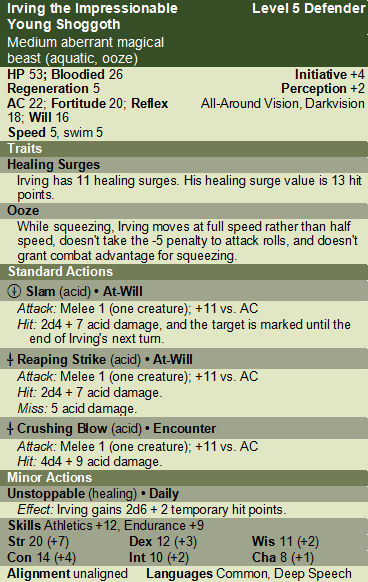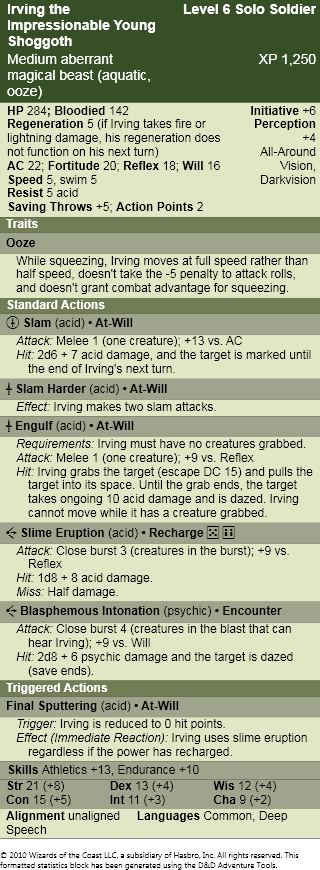This time, we're giving you an ally. This week's feature is Irving the Impressionable Shoggoth.
Irving is technically an NPC, but he's built as a companion creature using the rules from Dungeon Master's Guide 2. If you're worried about game balance, don't use him; his darkvision and innate regeneration abilities mean that he'll likely outshine the PCs. If you're not worried about game balance, then here he is. He's built as a 5th-level Defender, and acts as another party member in all respects.
Irving is a naïve, young adventurer who wants to see the world in the great tradition of such unlikely adventurers as Bilbo Baggins and Luke Skywalker.
Oh, and he's a shoggoth. The Mad Arab wrote the dreaded Kitab Al-Azif, and even these things frightened him.
Despite his power, Irving places adventurers in a precarious position, because as noted in his original writeup, he is likely to approach the PCs, and how do you say "no" to a half-ton shoggoth?
Irving has a lot to bring to the table. He's basically a fighter, but a fighter who cannot be flanked, can see in the dark, and regenerates. He doesn't carry a weapon, instead relying on his acidic pseudopods. As such, he can take a lot of heat.
On the other hand, he's a shoggoth. He won't eat you while you're adventuring, but he might turn on you eventually. Indeed, if he is reduced to 0 hit points and revived, he needs to make a saving throw at -4. Failure indicates that he has forgotten himself, possibly causing him to assume another party role and take on the characteristics of another class. He might even become a mindless shoggoth.
Anyway, without further ado, here's Irving:
Note that he has some traits of the impressionable young shoggoth, but he has some from the original Call of Cthulhu writeup (notably the aquatic feature). Feel free to add any traits from either version, to taste (like allowing him to reproduce scrolls at no cost with a chance that he learns the ritual).
When the PCs inevitably offend Irving or when he turns on them in a level or so, I also wrote Irving as a monster so he can reasonably provide a challenge for a group of PCs. This version definitely has more in common with a Call of Cthulhu shoggoth, both to its advantage and disadvantage.
Addendum: If you look at the comments, the good folks at Hereticwerks note that Irving's original Labyrinth Lord entry depicts him using weapons.
No problem.
As written, Irving's companion entry uses greatclub statistics for his Slam attack. You can easily swap the Slam attack for a weapon attack; the greatclub gives Irving's attacks a +2 proficiency bonus and 1[W] is 2d4. Just swap out the bonus and damage as appropriate. As all companion characters, Irving has no use for magical items or gear, and so should never be given a share of the treasure.
Since Irving has a decent Slam attack, and since he probably doesn't know his own strength and is basically a blob of sentient acid, DMs might want to assume that any weapon he wields breaks on a natural "1." He will then revert to his Slam attacks as noted in the above entry.


Oh, he's so darling! I want there to be a cartoon series about him or something. I'll settle for a comic book or webcomic.
ReplyDeleteAwesome! Can I have one?
ReplyDeleteVery cool. Irving can use weapons though, but he does tend to break them. A lot. The notion of Irving in a web comic is frightening. It could be fun though...
ReplyDeleteHis "Slam" attack basically acts as a greatclub, so enterprising DMs can switch his attacks to represent any weapon.
DeleteDMs who wish to represent his hideous strength and corrosive miasma might consider breaking his weapons on a natural 1, causing him to default to Slam attacks.